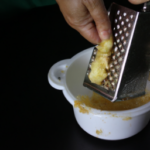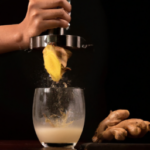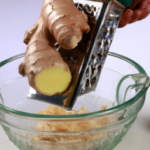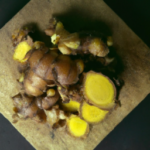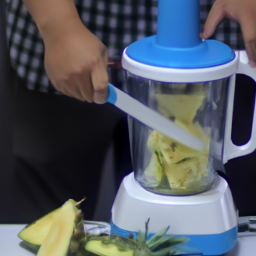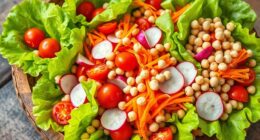I have always loved making juices, and ginger root is one of my favorite ingredients to use in my juice recipes. Ginger not only adds great flavor but also provides numerous health benefits like reducing inflammation, aiding digestion, and boosting the immune system. However, juicing ginger root can be difficult because of its tough, fibrous texture.
In this article, I will share my personal tips and tricks on how to juice ginger root effectively and safely.
First and foremost, it’s essential to select the right ginger root. Look for fresh, firm, and smooth ginger with no wrinkles or soft spots. The skin should be thin and free of blemishes. When choosing ginger, also consider the intensity of its flavor; young ginger tends to be milder, while mature ginger is more pungent.
Once you’ve selected your ginger, it’s time to prepare it for juicing.
Key Takeaways
- Select fresh, firm, and smooth ginger root for juicing to avoid spoilage and mold.
- Grate or slice ginger root before juicing to extract more flavor, and peel it beforehand.
- Masticating juicers produce higher-quality juice with more nutrients and enzymes than centrifugal juicers.
- Proper storage of ginger juice is important for maintaining freshness and flavor, short-term in an airtight container in the fridge and long-term in the freezer.
Choosing the Right Ginger Root
You’ve got to make sure you choose the freshest, firmest ginger root possible to get the most flavor and health benefits out of your juice. Selecting quality ginger root is essential to ensure that you get the most out of your juicing experience.
It’s a good idea to purchase ginger root from a reputable store that has a high turnover rate to ensure freshness. Fresh ginger root should be firm to the touch and have smooth skin.
Avoiding spoiled ginger root is crucial because it can cause mold and spoilage in your juice, which can be harmful to your health. Always check for any signs of mold or discoloration before purchasing ginger root.
Now that you know how to select the best ginger root for juicing, let’s move on to preparing ginger root for juicing.
Preparing Ginger Root for Juicing
Get ready to add some zing to your juicing routine with this simple preparation step. When it comes to juicing ginger root, there are two main ways to prepare it: grating and slicing. Grating ginger allows for more surface area to be exposed, which can result in more flavor being extracted. Slicing, on the other hand, can be a bit easier and less time-consuming.
Whichever method you choose, it’s important to peel the ginger first to remove any tough outer layer. You can use a vegetable peeler or the edge of a spoon to do this.
One popular way to consume ginger juice is through ginger shots. These small, concentrated doses of ginger are said to have many health benefits, including reducing inflammation and aiding in digestion. To make a ginger shot, simply juice a small piece of ginger and drink it straight or mix it with other juices or water.
With its spicy and invigorating flavor, ginger juice can be a great addition to any juicing routine. Speaking of which, let’s move on to using a juicer.
Using a Juicer
Using a juicer can be a quick and efficient way to extract the nutrients and flavors from fresh produce, but have you ever wondered which type of juicer is best suited for your needs?
There are two main types of juicers: centrifugal and masticating. Centrifugal juicers work by shredding the produce with a fast-spinning blade and then separating the juice from the pulp. They’re generally more affordable and faster than masticating juicers, but they can also produce more foam and heat, which can affect the quality of the juice.
Masticating juicers work by slowly crushing and squeezing the produce, which results in a higher yield and less foam and heat. They’re typically more expensive and slower, but they also produce a higher-quality juice that retains more nutrients and enzymes.
When juicing ginger root, there are a few techniques you can use to get the most flavor and nutrition out of it. One method is to peel the ginger root first, as the skin can be tough and fibrous. Another technique is to grate or finely chop the ginger before juicing it, as this can help release the juices and flavors more efficiently.
You can also experiment with different flavor variations by combining ginger with other fruits and vegetables, such as apples or carrots. However, keep in mind that ginger can be quite strong and spicy, so you may want to start with a small amount and gradually increase it to your taste.
To continue with using a blender, you can also make ginger juice by blending the ginger root with water and then straining it through a fine mesh sieve or nut milk bag. This method can be a bit messier and produce more pulp, but it can also result in a smoother and creamier texture.
Using a Blender
When blending ginger root, using a blender is an alternative method to using a juicer. It’s important to choose a blender that can handle tough ingredients and produce a smooth consistency when blending fruits and vegetables. Here are some blender techniques to keep in mind:
- Cut the ginger root into small pieces before blending to ensure it blends evenly.
- Add a small amount of liquid, such as water or juice, to help the blending process.
- Start blending on low speed and gradually increase to high speed to ensure the ginger is fully blended.
Using a blender to juice ginger root can result in a thicker consistency compared to using a juicer, but it’s still a great alternative method. Adding ginger to your juice recipes can provide a spicy kick and potential health benefits.
Adding Ginger to Your Juice Recipes
Looking to spice up your daily drink routine with a unique flavor and potential health benefits? Have you ever considered adding a zesty root with a kick to your juice recipes? Ginger root could be a great addition to your juicing regimen. Not only does it add a delicious and distinctive taste, but it also comes with a range of health benefits.
Ginger is known to have anti-inflammatory and antioxidant properties, making it a great ingredient for reducing inflammation in the body and boosting the immune system. It is also known to aid in digestion, relieve nausea, and reduce muscle pain. If you’re not a fan of ginger’s taste or looking for alternatives, you can try adding turmeric, cinnamon, or even a slice of lemon to your juice recipe. These alternatives also come with their own range of health benefits. In the next section, we’ll discuss how you can adjust the flavor of your ginger juice to suit your taste buds.
Adjusting the Flavor
To make your drink more enjoyable, you can adjust the flavor of your ginger-infused concoction to suit your taste buds. Here are three ways to do it:
-
Adding sweeteners: Ginger can be quite spicy, and if you find that the flavor is too strong for you, try adding some sweeteners like honey, agave syrup, or stevia. These natural sweeteners can help balance out the heat and give your drink a more pleasant taste.
-
Balancing flavors: If you prefer a more complex flavor profile, try adding other fruits or vegetables to your juice mix. Apples, carrots, and oranges can all complement the flavor of ginger and make your drink more interesting. Experiment with different combinations until you find the perfect balance.
-
Adjusting the amount of ginger: If you find that the ginger flavor is too strong, try reducing the amount of ginger root you use. Start with a small piece and gradually increase the amount until you find the right balance for your taste.
Now that you’ve adjusted the flavor of your ginger juice, it’s time to store it properly to ensure maximum freshness and flavor.
Storing Ginger Juice
Despite its strong flavor, storing ginger juice properly is crucial to maintain its maximum freshness and flavor. Ginger juice can be stored for both short and long term periods. However, long term storage requires a bit more effort to ensure the ginger juice retains its nutritional benefits.
For short term storage, place the ginger juice in an airtight container and refrigerate it. This will keep the juice fresh for up to a week. However, for long term storage, freezing is the best option. Simply pour the ginger juice into an ice cube tray and freeze it. Once frozen, transfer the ginger juice ice cubes to a freezer-safe container. This method can keep the ginger juice fresh for up to six months. It is important to note that the longer the ginger juice is stored, the more potent and spicier it becomes.
Now that we know how to properly store ginger juice, let’s move on to how we can use it for its health benefits without losing its nutritional value.
Using Ginger Juice for Health Benefits
If you’re looking to spice up your health routine, adding a touch of zing with a ginger kick might be just the thing to give you a boost. Ginger juice is a potent ingredient that can be easily incorporated into your daily routine, providing numerous health benefits.
Here are some of the benefits of ginger shots and incorporating ginger juice into your diet:
- Reduces inflammation: Ginger has anti-inflammatory properties that can help reduce muscle pain and soreness after exercise.
- Boosts digestion: Ginger can help alleviate gastrointestinal discomfort by increasing the production of digestive juices.
- Lowers blood sugar: Studies have shown that ginger can help regulate blood sugar levels and improve insulin sensitivity in people with type 2 diabetes.
- Improves brain function: The antioxidants in ginger can help protect against oxidative stress and improve cognitive function.
- Boosts immune system: Ginger has antiviral and antibacterial properties that can help strengthen the immune system and protect against illness.
Incorporating ginger juice into your daily routine is easy. You can add it to smoothies, teas, or even use it as a marinade for meat or vegetables. However, it’s important to note that ginger can interact with certain medications and should be consumed in moderation.
In the next section, we’ll discuss some precautions and considerations to keep in mind when using ginger for its health benefits.
Precautions and Considerations
Before incorporating ginger juice into my diet, it’s important to consider potential side effects.
While ginger is generally safe, consuming too much may cause digestive issues or interact with certain medications.
It’s also a good idea to consult with a doctor, especially if I have a preexisting medical condition or take prescription medications.
By being mindful of these precautions, I can enjoy the health benefits of ginger juice without any negative consequences.
Potential Side Effects
Be aware that juicing ginger root may cause some potential side effects, such as heartburn, stomach upset, and diarrhea. These side effects may occur due to the high concentration of gingerol and shogaol found in ginger root.
It’s important to start with a small amount and gradually increase as tolerated to minimize the risk of experiencing these side effects. To avoid any complications, it’s best to consult with a doctor before incorporating ginger root juice into your diet, especially if you have any pre-existing medical conditions.
Your doctor can also advise you on the appropriate dosage and frequency of consuming ginger root juice. Remember, taking precautions and considering potential side effects is necessary when introducing any new food or supplement into your diet.
Consulting with a Doctor
Consulting with a doctor is essential before adding ginger to your diet, as they can provide guidance on safe dosages and potential interactions with any existing medical conditions. Ginger may offer numerous health benefits, but it’s important to consider its potential risks as well.
For example, ginger can thin the blood and increase the risk of bleeding, especially if you’re taking blood-thinning medication. Additionally, consuming too much ginger can lead to digestive issues such as heartburn, bloating, and diarrhea.
It’s important to discuss any concerns with your doctor to ensure that ginger is safe for you to consume. By consulting with a medical professional, you can make informed decisions about incorporating ginger juice into your diet and avoid any potential harm.
As you move forward with experimenting with ginger juice, it’s important to keep in mind the guidance provided by your doctor and start with small doses to monitor how your body reacts. It’s also important to consider the source and quality of the ginger root used to ensure that you’re getting the maximum health benefits.
Experimenting with Ginger Juice
I’m excited to experiment with ginger juice and try out new recipes. Mixing ginger juice with other ingredients like lemon, honey, or turmeric can create a delicious and healthy drink.
It’s important to keep in mind the potential benefits and risks of each ingredient when experimenting with different combinations.
Trying New Recipes
You’ll be pleasantly surprised at the delicious and unique flavors you can create by trying out new ginger root juice recipes. You can mix ginger juice with a variety of fruits and vegetables to create refreshing and healthy drinks. Here are some juice pairing ideas for you to try out:
| Ginger Juice | Fruit/Vegetable |
|---|---|
| Ginger and Pineapple Juice | Pineapple, Apple, Carrots |
| Ginger and Beetroot Juice | Beetroot, Apple, Lemon |
| Ginger and Orange Juice | Orange, Carrots, Lemon |
| Ginger and Carrot Juice | Carrots, Apple, Pineapple |
| Ginger and Cucumber Juice | Cucumber, Lemon, Mint |
These juice pairing ideas are just a starting point. You can experiment with different fruits and vegetables to find the perfect combination that suits your taste buds. Once you’ve tried out a few recipes, you can start mixing ginger juice with other ingredients to create even more unique flavors.
Mixing with Other Ingredients
To create even more unique and flavorful combinations, I love experimenting with mixing ginger with other ingredients.
One of my favorite combinations is ginger and turmeric, which are both anti-inflammatory and have a warm, earthy flavor.
Another great option is ginger and lemon, which gives a refreshing and zesty taste.
I also like to add a pinch of cinnamon to my ginger juice for a touch of sweetness and spice.
When it comes to juicing techniques, it’s important to keep in mind that some ingredients may require more effort to juice than others.
For example, leafy greens may need to be bunched up tightly to ensure maximum extraction, while fruits like apples can be juiced without any additional preparation.
When mixing ginger with other ingredients, it’s best to juice them separately and then combine them afterwards to ensure a balanced flavor.
With a bit of experimentation, you can discover your own favorite flavor combinations and juicing techniques to create delicious and nutritious ginger juices.
Frequently Asked Questions
Can I use frozen ginger root for juicing?
Yes, I use frozen ginger root for juicing. It’s convenient and I still get the same health benefits. For ginger root tea, frozen ginger root also works well and can be stored longer.
How much ginger juice should I consume per day for its health benefits?
I consume 1-2 ounces of fresh ginger juice daily to reap its many health benefits, including reducing inflammation and aiding digestion. It’s important to start with a small dose and increase gradually. Consult with a healthcare provider before adding ginger shots to your routine.
Can I mix ginger juice with other juices or should I drink it separately?
Should I mix ginger juice with other juices? It’s best to consume ginger juice on an empty stomach for maximum benefits. Mixing with other juices may dilute its potency.
How long can I store ginger juice in the refrigerator?
I store ginger juice in the refrigerator for up to a week. To preserve its freshness, I use an airtight container and add a squeeze of lemon juice. Shake well before drinking. Storage tips are crucial for maintaining its potency.
Can I use a regular blender instead of a high-speed blender for making ginger juice?
I’ve tried blender alternatives for making ginger juice recipes and found that a regular blender works fine. Just blend the ginger with water and strain. A high-speed blender may yield a smoother juice, but it’s not necessary.
Conclusion
In conclusion, juicing ginger root is a great way to add a powerful punch of flavor and health benefits to your daily routine. Like a superhero in a comic book, ginger root is a humble ingredient that packs a mighty punch. It possesses anti-inflammatory properties, aids in digestion, and can even help alleviate nausea.
Just like a superhero, ginger root has its limitations and precautions, so it’s important to consult with a healthcare professional before consuming large amounts. With the right preparation and storage, juicing ginger root can be a delicious and nutritious addition to your diet.
So why not give it a try and unleash the power of ginger in your daily juice routine?
Ilana has been a vegan for over 10 years. She originally made the switch for health reasons, but soon found herself becoming more and more passionate about the ethical and environmental implications of a vegan lifestyle. Ilana is the author of The Graceful Kitchen, a blog all about veganism. She loves to cook up delicious and nutritious vegan meals, and share her recipes with others who are interested in leading a cruelty-free life. Ilana is also a strong advocate for using whole foods as the foundation of a healthy diet, and believes that going vegan is one of the best ways to achieve this.



